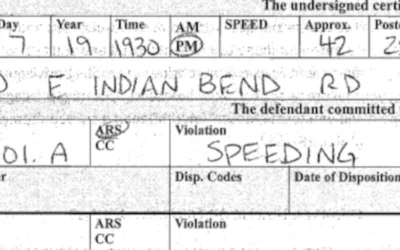What Counts As Evidence In Court?
First, what can be evidence?
1. Physical Evidence
Evidence can take a number of forms. Most people, when they think of evidence, think of physical evidence – something tangible that you could hold in your hands or see with your eyes. Physical evidence could include:- The glove from O.J. Simpson’s trial.
- Audio recordings like a 911 call.
- Videos, including body camera, dash camera, security cameras, and more.
- Photographs.
- AVL or GPS data.
- Documents
2. Witness statements.
Evidence also includes statements. Think of the statement or testimony of a witness or a police officer. A person can tell the court what they saw or what they know, and that is evidence.
In traffic violation cases, often the only evidence available are the statements of the police officer who issued the ticket, and the statements of the driver.
Take an excessive speed case for example. Typically, there is a police officer testifying that he measured a driver’s speed with a radar gun. There is almost always no video of the radar gun showing the speed, and no record of the speed measurement other than the police officer’s statements.
As you can imagine, there can be some serious problems with oral testimony.
1. Oral testimony relies on the memory of the witness.
Witnesses are notoriously unreliable. Consider a traffic ticket case. The case might go to trial 6 months or more after the actual traffic stop occurred and the ticket was issued. A police officer might do 12+ traffic stops in a given day. That means a police officer might have done 1,500 traffic stops or more since he issued the ticket that is going to trial. Do we really believe a police officer remembers all of those traffic stops?
2. There is no reliable way to tell if a witness is lying.
Consider this possibility. A police officer measures the speed of a speeding vehicle with his radar unit. The vehicle was not speeding, so the police officer pulls over the driver and fabricates a story about measuring a speed on his radar unit that was in excess of the posted speed limit. The driver is adamant that he was not speeding, but still gets a ticket. The only “evidence” at a trial would be the testimony of the police officer and the driver. It is often impossible to prove the police officer was lying. It is then up to the judge to determine who – the police officer who regularly appears in that court, or the defendant – is the more credible witness.
If you drive, get a dash camera. That camera generates physical evidence that could save you in court.
Restrictions on Evidence in Court
Not all statements, physical objects or videos are allowed to be presented in court though. There are many restrictions in the rules of evidence. I cover three common restrictions here.
Evidence Must Be Relevant
For example, evidence must be “relevant”. Rule 401 of the Arizona Rules of Evidence says that “Evidence is relevant if: (a) it has any tendency to make a fact more or less probable than it would be without the evidence; and (b) the fact is of consequence in determining the action.
“The fact is of consequence in determining the action.” What does that mean? It means that to be relevant, the evidence has to go the heart of the matter. For example, a security camera video of a defendant’s car crashing into another car and then leaving would go to the heart of the matter in a hit and run case. A video of the defendant’s dog eating a cookie would not.
Similarly, a video of a defendant crashing into a car and then driving off would tend to make a fact (the defendant hitting a car and driving off) more or less likely. Such a video would definitely be relevant then.
No Character Evidence
A defendant cannot present evidence of their past good character to show that they did not commit the alleged crime because committing such a crime is inconsistent with their historical behavior.
This cuts two ways though. Similarly, the prosecution cannot introduce evidence of a defendant’s prior criminal acts to argue that the defendant was acting consistent with his prior criminal behavior when they committed the charge at issue in trial.
Character details can still be useful in a criminal case though for purposes of negotiating or arguing for a more lenient sentence following a conviction.
No Hearsay
I have to mention hearsay because this is a common issue with oral evidence or testimony.
The definition of hearsay is: An out of court statement admitted in court to prove the truth of the matter asserted.
Consider, for example, a shoplifting case. The defendant who has been charged with shoplifting a Snickers bar, says in court, “The store clerk told me I could take the Snickers bar without paying.”
The clerk’s alleged statement was made outside the courtroom at a store. The defendant is offering the statement to prove that he didn’t shoplift because the Snickers bar was given to him. This statement would not be allowed in court.
There are a number of exceptions to hearsay where such statements are admissible, but that’s too involved to include here.
Latest Blog Posts
Can you get a ticket in Arizona for driving a loud car?
Can you get a ticket in Arizona for driving a loud car?Unfortunately, YES. In today’s nanny state, it is certainly possible to get a ticket for the sounds your car makes. We actually see this a lot. The severity of the tickets can range from an annoying no-points...
What if a traffic ticket has the wrong information?
What If A Traffic Ticket Has The Wrong Information In Arizona?It is not unusual that a traffic ticket has the wrong information. We see all kinds of traffic tickets in our office from many different law enforcement agencies. Some tickets are entirely hand-written on...
Chris Rike is a founding partner of Traffic Law Guys, an Arizona law firm committed to protecting the rights of drivers facing criminal traffic charges.


